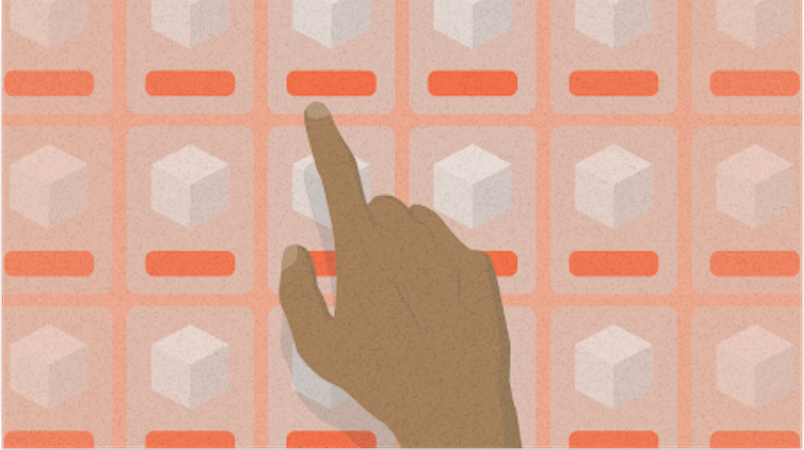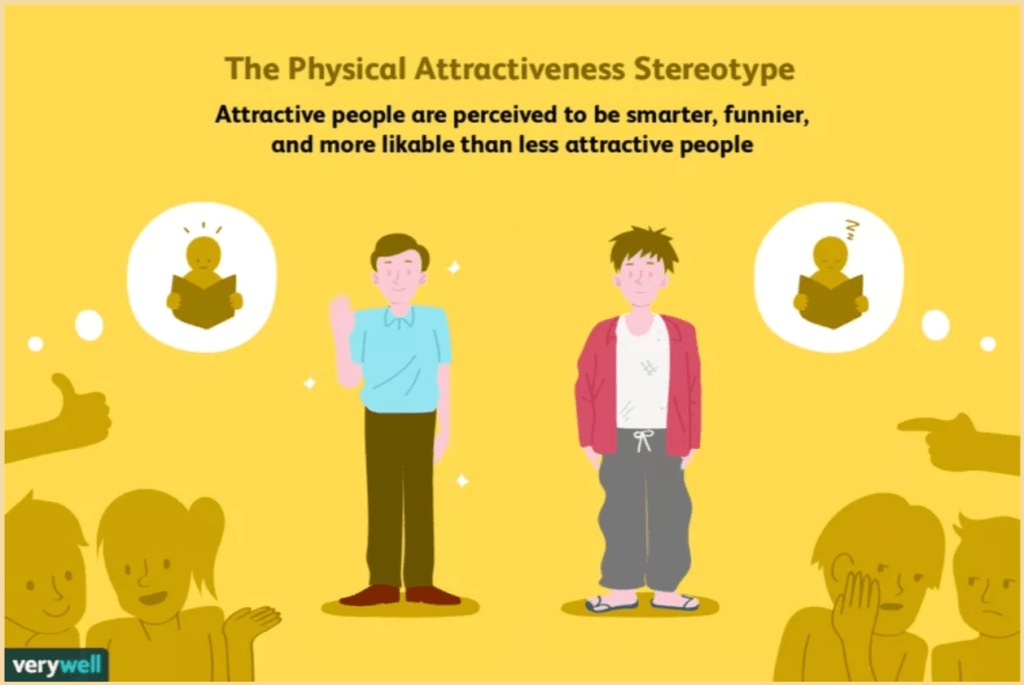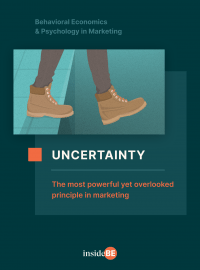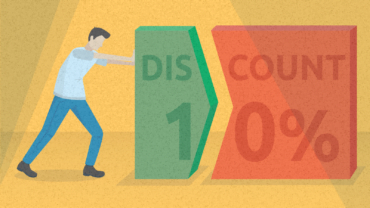Halo Effect – Everything You Need to Know

Article content:
Definition of the halo effect
The halo effect is a cognitive bias that occurs when our initial impression of someone unconsciously shapes our whole perception of the individual. The same thing can happen with people, brands, or products.
While it’s often caused by physical attractiveness, other attributes like kindness or hostility can determine our overall perception as well. When we generalize a negative first impression, it’s called the horn effect.

Discover ground-breaking ideas and fascinating solutions.
How it works
Remember your teenage years? For sure, at least once you fell in love with someone before you even learned their name. There you have it – the halo effect in action.
In that case, the person was probably very attractive, which formed your first impression. After the first impression is made, we don’t look for objective information to build a more complex image. Instead, we actively create a picture that fits that first impression.
It’s the same thing with brands. Imagine that after ripping up your running sneakers for years, you finally decided to buy some new ones. You opt for Nike.
We actively create a picture that fits that first impression.
From the first time you put them on, you are absolutely sure it’s the right choice. Every step feels like walking on air. On your first run, you immediately feel your pace increasing (or so you tell yourself). Best. Choice. Ever.
And after a while, what happens when you need a new hoodie, shorts or running jacket? “Well, I’m sure that Nike’s shorts are every bit as great as their shoes”. After such a great experience with one of their products, you make an assumption about their others. There it is again – the halo effect.
Why it works
Let’s get back to the example of your first love. In fact, attractiveness has a lot to do with the halo effect when it comes to people. Research shows that attractive people are rated as more successful, smarter, or funnier than their less attractive counterparts.

Source: Verywell mind
It’s not all about attractiveness, but it’s the first thing we notice and forms the first impression. After that, we look for information that confirms that impression. This is called confirmation bias. Why do we do this?
Because we hate uncertainty and the idea that the world could be chaotic and unpredictable. That’s why we make quick judgments that remove our uncertainty. It’s easy and convenient to idealize someone. And it also makes us feel less anxious.
Once we start to idealize someone and put a mental halo over their heads, it’s very hard for us to let go of that idea. Admitting we are wrong would cause something called cognitive dissonance. Simply put, that means our thoughts wouldn’t be consistent with the world around us. This brings us back to the world being chaotic.
Halo effect experiments
Physical attractiveness makes you seem like a better person
In a study by Dion, Berscheid and Walster, participants were presented with three different photos of an attractive, unattractive, and averagely attractive person. Then, they were asked to judge the people on 27 different personality traits, to predict their life happiness and their chance of getting a job with high status.
Results showed that most of the participants overwhelmingly believed that attractive people had more socially desirable personality traits, would lead happier lives, have happier marriages, and have more career success than averagely attractive or unattractive people.
Attractive people had more socially desirable personality traits, would lead happier lives, have happier marriages, and have more career success than averagely attractive or unattractive people.
Being nice impacted a teacher’s rating
In 1977, Nisbett and Wilson showed 118 college students one of two videos. Both of them showed a male Belgian teacher who spoke English with a heavy accent. In one of the videos, the teacher was nice to his students, while in the other, he was rather rude. Participants then rated the teacher’s physical appearance, mannerisms, and accent.
The authors found that 70% of the participants rated the teacher as appealing when he was being nice and irritating when he was impolite. When the teacher was rude, 80%of the students rated his accent as irritating. The percentage dropped to 50 percent when he was being kind.
70% of the participants rated the teacher as appealing when he was being nice and irritating when he was impolite. When the teacher was rude, 80%of the students rated his accent as irritating. The percentage dropped to 50 percent when he was being kind.
Good mood influences the halo effect
Researcher Joseph Forgas decided to examine whether mood can impact how strongly the halo effect takes place. He asked his participants to read a philosophical essay with an image of the writer attached. Some participants received an essay with a picture of an elderly man, while others were given a picture of a young woman. They had to judge the author’s “philosophical attributes”.
However, before that, participants were asked to remember and write about either their positive or negative life experiences. This was supposed to induce either a negative or positive mood.
The results were clear. There was an overall halo effect as the old male writer was perceived as more competent, given his “philosopher” look. However, those who chose to write about positive life events were much more prone to this halo effect and rated him even more competent than those who wrote about negative experiences.
Those who chose to write about positive life events were much more prone to this halo effect and rated him even more competent than those who wrote about negative experiences.
Thus, the study suggests that the effect of this bias could be strongly impacted by the mood we are in.
History of the halo effect
The first person who ever coined the term halo effect was the famous psychologist Edward Thorndike – one of the great grandfathers of behaviorism, the dominant stream of psychology back in the day.
It was in the 1920s and, unsurprisingly, the research took place for military purposes. Thorndike was tasked with studying how commanding officers evaluated a variety of qualities in their subordinate soldiers.
He found that certain characteristics (read – physical appearance) strongly influenced the soldiers’ rating in seemingly unrelated metrics. More athletic soldiers were ranked as more intelligent, better leaders, and overall better people.
As mentioned earlier, the name ‘halo effect’ implies that we put a halo over someone’s head, thus perceiving them as saints with no imperfections.

Source: UXShots
How to avoid it?
Cognitive biases such as the halo effect work best when we let our quick and intuitive reasoning lead the way. However, once we slow down and realize what might be going on, we can avoid it. So, how do we do that?
- Keep in mind that the effect exists. Especially when you get excited about a person or a brand, it can be quite easy to fall for this bias. One of the best ways to handle that is to be aware of it and consider too much excitement as a red flag.
- Don’t decide right away. Are you facing an important decision? You don’t need to decide right away. Schedule another meeting or simply take a day or two to cool down. This is called a cooling-off period.
It has been applied by several countries in order to reduce divorce rates. According to a study by researcher Jungmin Lee, a 3-week cooling-off period allowed people to let go of negative emotions and it reduced the divorce rate in South Korea by about 10%. - Make a checklist. Once a certain product steals your heart, it’s hard to let go. So, before you go on a shopping spree, make a checklist of must-have attributes. It will make it easier for you to turn the offer down, even if it makes a great first impression.
Examples of the halo effect
Attractiveness influences health perception
That’s right. One of the characteristics of cognitive biases is that it affects everybody. Thus, there’s a danger that we could take the symptoms of our nearest and dearest lightly, but the halo effect could cause even skilled professionals to misjudge patients’ health if they are attractive.
For example, in a study done by Kalick and his colleagues, researchers showed participants photos of over 300 men and women in late adolescence. Then, they asked them to judge the person’s health. The results showed that attractive people were generally judged as healthier.
Charisma and education as a halo effect in hiring
Hiring new employees is one of the areas the halo effect can really shine. What is more, it can be formed even before the job interview begins. How? Via CV.
For example, it might be the case that the candidate studied at a top university, which will cause hiring managers to consider the candidate a genius right from the beginning. Or perhaps the candidate did an internship in a prestigious company. Even when the internship lasted just about a month, it’s long enough to form an impression.
The first impression of a website impacts your perception of the whole company
Have you ever been desperately searching for a birthday present but couldn’t find it anywhere online? Then finally, you come across an e-shop you’ve never heard of that claims to have it.
You open their website, and it looks like it’s from 2001. Would you trust it with your purchase?

Source: Version Museum
No, you probably wouldn’t. The first impression you get from the website creates a halo effect, (or in this case a horn effect) and has a major influence on how trustworthy you deem the whole company.
If you run a business, make sure your landing page meets today’s standards. If it doesn’t, it will look suspicious and will drive customers away.
How can you use it in business?
Dress to impress
If you are in a B2B business, you spend countless hours in business meetings trying to convince your prospects of your undeniable qualities. And those might truly be exceptional, but that doesn’t matter if you can’t convince your clients of that fact. And if you show up in ripped jeans, you won’t help your case very much.
So, what can be done? The simplest thing you can do is to look good.
Remember, good-looking people are perceived as funnier, more intelligent, and even more trustworthy. So adjust your wardrobe accordingly. You’ll make a better impression and increase your chances of making a deal.
Take care of your visual identity and website
If you already learned anything from the examples above, it is that a crappy website can make a terrible impression and take your whole company down. Avoid that – impress your customers in the first seconds they find you online.
There are several ways to do that. Here are three tips:
- Web design: Make sure your landing page looks professional and is up to date with the latest trends. If it looks outdated, it will feel less trustworthy, and your customers will hesitate to get in touch with you.
- User experience: Nothing is more frustrating than an unresponsive website, buttons that lead nowhere, or elements that don’t make any sense. If the company can’t take care of such a basic thing as its own website, how can it take care of its customers?
Your website should be intuitive, easy to navigate, and customers should be able to find what they’re looking for quickly. These elements form a good UX and will cause customers to view you more positively. - Visual identity: Is your product great and your website responsive, but your visuals look like they were drawn by a 6-year-old? You won’t get very far with that.
Don’t try to save money on your visual identity. From your logo, through PowerPoint presentations, all the way to the PDFs the customers can download from your website, it all needs to look professional. Don’t hesitate to hire brand consultants to help you with that. It’s money well spent.
Don’t make quick decisions
Remember, cognitive biases like the halo effect are subconscious and can affect your decisions without you even knowing. Especially in the case of big decisions, when you are sure you’re approaching them rationally.
Take your time. No matter how big the decision you are facing, it can be tempting to make a quick judgment. Even when the decision is already made, take some time for it to settle. Schedule another meeting in a day or two, so the cooling-off period can kick in.
When it does, you might find yourself doubting your own decisions. In some cases, this can save you a lot of money.
Summary
What is the halo effect?
It occurs when someone or something makes a good first impression on us. In cases like these, we are prone to generalize this impression to other areas as well.
For example, when we buy a new phone from a certain brand and have a great experience with it, we assume that this brand also makes other products just as great. When someone is charming and attractive, we assume they are also more intelligent and funnier.
Why does it happen?
It’s related to multiple other psychological effects:
- Ambiguity aversion: We hate uncertainty and the idea that the world could be chaotic. That’s why we make quick judgments that remove this uncertainty.
- Confirmation bias: Once a first impression is formed, we tend to look for information that confirms our beliefs.
- Cognitive dissonance: After the halo effect kicks in, admitting that we are wrong would cause cognitive dissonance: Our thoughts wouldn’t be consistent with the world around us. This wouldn’t be very pleasant for us so, to avoid it, we again confirm ourselves in our prior beliefs.
How can you avoid it?
It’s important to be aware that the halo effect exists. When you get too excited about a brand or a person, you might consider it a red flag signaling the halo effect.
When you’re facing a big decision and you know that you might be falling for the halo effect, don’t decide right away. Take a day or two to cool down. This is called a cooling-off period and it has been shown to “cool off” the emotions that cloud our judgments.
The halo effect can, for example, cause you to overweight certain aspects of a product, such as a beautiful design. To avoid that, make a checklist of must-have attributes and stick to it.
How can you use it in business?
It all comes down to making a great first impression on the customer. To do so, you need to look good – both offline and online. Adjust your wardrobe to make yourself look professional, and take care of how your landing page looks as well.
It also needs to be intuitive and responsive if you want the best user experience for your customers. An appropriate visual identity is important as well if you want to use the halo effect to your advantage.




